

Open City - Civic apps built with open data. От города воображаемого к городу-фикции</u> Urban landscape perspectives. The Big Rethink: Integral Theory.
The Rise Of The Supertalls. New York City launches competition to create the perfect payphone. New York City Mayor Michael Bloomberg has challenged designers to come up with ideas for the next generation of public payphones.

Bloomberg says the Reinvent Payphones Design Challenge will get New York's "dynamic and ever-growing tech community to ‘Re-Own the Phone' and provide their ideas on what the future of payphones could entail. " New York City announces six ambitious finalists in payphone design challenge. The City of New York this week announced the six finalists in its Reinvent Payphones challenge — an initiative that invites students, urban planners, and designers to propose their visions for the payphone of the future.

The finalists were selected as winners in six different categories, and are now in the running for the Popular Choice Award, to be determined later this month. Not surprisingly, interactive and digital features play a major role in most of the six designs, including NYC/IO, winner of the Community Impact category. #betaNYC, a Code for America Brigade for NYC (New York, NY. BetaNYC is building a better tomorrow for all.
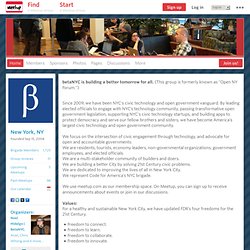
(This group is formerly known as "Open NY Forum. ") Since 2009, we have been NYC's civic technology and open government vanguard. By leading elected officials to engage with NYC’s technology community, passing transformative open government legislation, supporting NYC's civic technology startups, and building apps to protect democracy and serve our fellow brothers and sisters, we have become America’s largest civic technology and open government community. The Code for America Brigade. Город-сад. MEDIACITY. Urban HCI: Spatial Aspects in the Design of Shared Encounters for Media Façades.
Different types of spaces and displays.Most of our inter-ventions were re-corded to identifyinteraction patternsand spatial effects.Collected data in-cludes photos andvideos recorded ‘onthe ground’, as wellas maps, aerial pho-tos and videos froman elevated posi-tion, as well as fieldnotes and inter-views with users.Analysis and com- parison of this ma-terial informed thedevelopment of our model (Fig. 5).
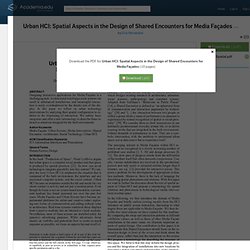
Thiswas derived via asystematic iterativeanalysis of the data,focusing on the im- plications of spatialconfigurations,from which thecategories in our model successivelyemerged.In the following we characterise types of spaces and dis- plays to describe the different venues and compare configu-rations of urban installations. Comparing these with other systems installed at the same location, we highlight coredifferences in configuration and propose a terminology thatoffers a framework for describing spatial setups for SharedEncounters. Basic Categories Display Space. Chrome Web Lab. Web Lab is a groundbreaking, year-long exhibition, featuring a series of interactive Chrome Experiments that bring the extraordinary workings of the internet to life.

Google Creative Lab and Tellart created the concept of the Web Lab–from the user-experience as an integrated online and onsite experience, to its science museum context and audience, to the optical Lab Tag method for collecting artifacts, to the interactions between digital and physical touchpoints which allow in-museum and online audiences to collaborate.
Visitors to the London Science Museum are able to play with five unique installations, while at the same time, online participants can visit www.chromeweblab.com and interact with the same installations. Together, in-museum and online visitors will bring web technologies to life through five experiments: Universal Orchestra: An Internet-powered eight-piece orchestra creating harmonious music Photos: Andrew Meredith. SoundAffects NYC. A ten-day audio experiment that listened to more than just the audible noise of a New York City street corner, SoundAffects took the form of a wall on the corner of 5th Avenue and 13th Street that collected data input including temperature readings, color analysis of video feeds, precipitation measurements, noise levels, cellular phone activity/interference, and proximity sensors.

All of this raw data was fed into the SoundAffects generative music algorithm and visualizer system. We worked with mono for client Parsons The New School for Design, and the goal was to encourage engagement with the city environment. The music, and the corresponding visuals and video, were available in near real-time through the browser or your phone.
The project was completed using HTML5, JavaScript, Max/MSP/Jitter, Ableton Live, and various other software tools. On the hardware side, Tellart rigged industrial sensors to an Arduino micro-controller, and also captured live video throughout the ten days. Power to the people. Marcin Jakubowski: frei zugängliche Open Source-Entwürfe für Zivilisation. Living systems. Some scientists have proposed in the last few decades that a general living systems theory is required to explain the nature of life.[1] Such general theory, arising out of the ecological and biological sciences, attempts to map general principles for how all living systems work.

Instead of examining phenomena by attempting to break things down into components, a general living systems theory explores phenomena in terms of dynamic patterns of the relationships of organisms with their environment.[2] Theory[edit] Living systems theory is a general theory about the existence of all living systems, their structure, interaction, behavior and development. Urbanism_Theory_Writers_of_the_late_20th_C..jpg (1258×857) Jane Jacobs. Философ Джанни Ваттимо: «Люди, верящие в истину, крайне опасны — это агенты «здравого смысла» Итальянский политик и философ Джанни Ваттимо является одним из ведущих теоретиков постмодернизма. По его словам, современная культура характеризуется не только процессами в искусстве, но явлениями в социально-экономическими (наступление постиндустриальной эпохи) и религиозными (секуляризация и наступление постхристианской эпохи). «Теории и практики» поговорили с итальянским ученым о субъективности и интерпретации как главном сдерживающем механизме от тоталитаризма и перехлестов.
Исследование зимнего пейзажа Волхонки. Www.sed.manchester.ac.uk/architecture/research/csud/workshop/2011CityWeathers.pdf. Www.humtec.rwth-aachen.de/files/asr-6-261-2011.pdf. Torsten Hägerstrand. Torsten Hägerstrand (October 11, 1916, Moheda – May 3, 2004, Lund) was a Swedish geographer.
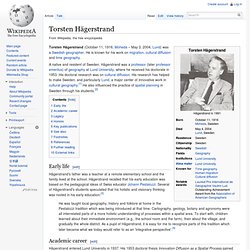
He is known for his work on migration, cultural diffusion and time geography. A native and resident of Sweden, Hägerstrand was a professor (later professor emeritus) of geography at Lund University, where he received his doctorate in 1953. His doctoral research was on cultural diffusion. His research has helped to make Sweden, and particularly Lund, a major center of innovative work in cultural geography.[1] He also influenced the practice of spatial planning in Sweden through his students.[2] Early life[edit]
Www.santafe.edu/media/workingpapers/11-09-046.pdf. Download.springer.com/static/pdf/735/chp%253A10.1007%252F978-3-642-31205-2_10.pdf?auth66=1355330309_fad0b8007b7e3be5536a9ca6c38b7fef&ext=.pdf. Unitech2010 - Conference Proceedings. Unitech2010 The International Conference on Universal TechnologiesOslo University College, Oslo, Norway, May 19-20, 2010.
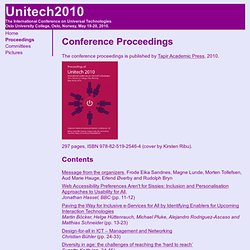
The conference proceedings is published by Tapir Academic Press, 2010. Norbert Streitz - Smart Future Initiative. Dr.
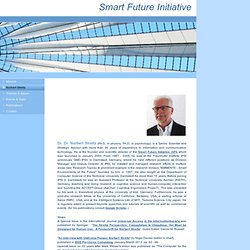
Dr. Norbert Streitz (Ph.D. in physics, Ph.D. in psychology) is a Senior Scientist and Strategic Advisor with more than 30 years of experience in information and communication technology. He is the founder and scientific director of the Smart Future Initiative (SFI) which was launched in January 2009. Interview mit Dr. Dr. Norbert Streitz. Location-based service. LBS are used in a variety of contexts, such as health, indoor object search,[5] entertainment,[6] work, personal life, etc.[7] LBS include services to identify a location[8] of a person or object, such as discovering the nearest banking cash machine (a.k.a. ATM) or the whereabouts of a friend or employee. LBS include parcel tracking and vehicle tracking services. LBS can include mobile commerce when taking the form of coupons or advertising directed at customers based on their current location. They include personalized weather services and even location-based games. Sentient City Survival Kit: Archaeology of the Near Future.
Bjarke Ingels Group. BIG is an architecture company, characterized by an entrepreneurial spirit, team-work across expertise areas and new ways of approaching conventional tasks. Smart Cities - Smart Future Initiative. There are many visions about the City of the Future, sometimes colorful illustrated as in the pictures shown below.
But do they communicate what we are actually looking for? What we need is a vision that reconciles humans and technology and, of course, also ecology. (the latter is very important but is not the focus of the research carried out in this context.) In short, we argue for a city where people enjoy everyday life and work,have multiple opportunities to exploit their human potential and lead a creative life.We call it “The Humane City”.The issues we are concerned with now are (besides the economic, political and social issues) How can information technology support people in such a humane city? The application of information technology in the context of future cities is often indicated by notions of Smart Cities or Ubiquitous Cities (u-cities).